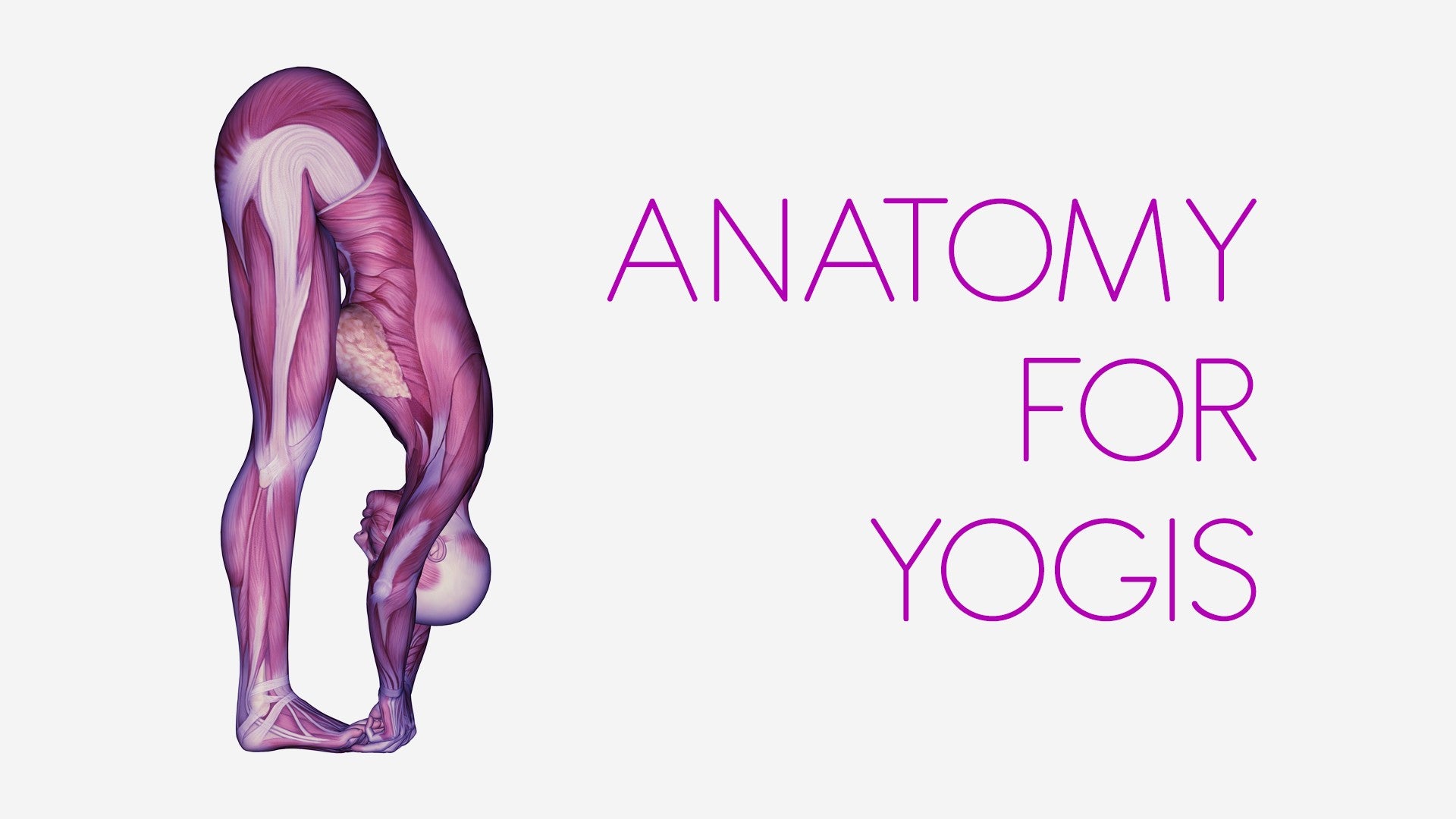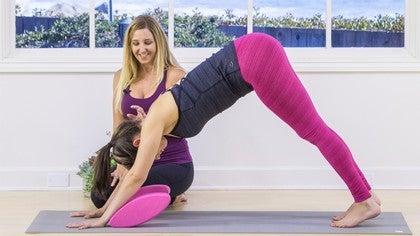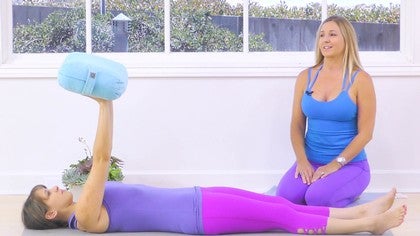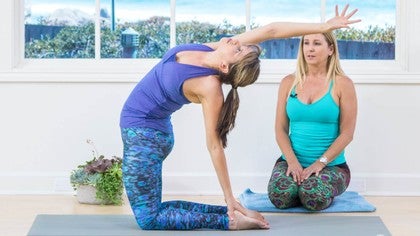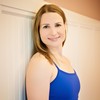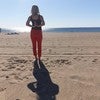Description
Transcript
Read Full Transcript
Hi, welcome back. I'm here today with Chelsea. She's my friend and my assistant and I'm so happy to have her in this class because I know Chelsea well and she's somebody that could really use this class. What we're going to do today is we're going to focus on the lumbar spine which is like your lower back basically and in most yoga instruction we do very little flexion or rounding of the lower back. We do a lot of hip hinging, a lot of neutral spine stuff and as a result that lower back which has so much range of motion potential doesn't get kind of what it has to offer and so we'll work on two skills today. One of them is to lengthen the lumbar so there's room for flexion which is rounding and extension which is back bending and then the other one is we're going to widen, sort of use some detailed skill work to get a sense that the lower back is spacious and broad. And so we'll start with some kind of easy drills to sort of teach the skill and then we'll move into some of the more fun and challenging poses. So what you will need before we get started is you will need a block and a bolster. So if you want to go ahead and get those now and then go ahead and line your back and you'll join us here so go ahead and lay down. I always like to begin classes with a body scan so just go ahead and with your knees bent up just see how you feel. See what is touching the ground and what isn't and particularly your lower back. Don't try and change anything right away. I know that there's a lot of rules out there on how you should lie and shouldn't lie. I don't have those rules. I just want you to notice when you lie on your back with your knees bent up what is touching the floor and then go ahead and stretch your legs out for a moment and see if that changes. Is there a big gap or no gap at your lower back? Just how's your pelvis feel? How does your rib cage feel? How many of your ribs are on the floor? And then go ahead and bend them back up and again notice the change and then go ahead and take your right hand and place it behind your head. And we have some muscles of the abdominal wall that really help us round the spine. The upper back, the thoracic spine with the ribcages easily rounds, easily flexes but the lumbar not so much so we're going to introduce how to use your abdominal muscles to find that here. So you're going to learn how to use these abdominal muscles to get some lower back flexion. So go ahead and put your hand on your belly, your left hand on your belly, your right hand is still behind your head and slowly start to curl yourself up looking between your thighs but notice what your belly is doing. Is it pushing up or is it helping your lower back kind of soften into the ground and then release down and then just repeat that. Keep doing that over and over. Don't drive your lower back into the ground. Just see if you can feel the two ends of these muscles so your pubic bone and your bottom of your sternum, can you just bring them together ever so slightly and feel the lower back get longer and more flexed. And your left hand on your belly is just giving you some feedback. And then from here you're going to add, just to make a little bit more challenging, add lifting the right knee in toward your chest every time you curl up. And again see if you can feel under your left hand the lower belly bringing your pelvis and your rib cage together and giving this length to the lower back. Do a couple more of those. And then switch legs. Keep the movement fluid here and just see what happens now when you cross contralaterally. That means opposite limb to opposite side. And just do a couple more here. You're not trying to do ab curls. You're not trying to fatigue yourself. All you're trying to do is notice the relationship between these muscles and the shape of your spine. Do one more and then lay down and rest. Both hands by your side. Legs bent up. Notice what's touching the floor. Stretch your legs out. Notice what's touching the floor. Compare your right side and your left side. And then bend your knees back up and let's switch sides. Left hand goes behind your head. Right hand goes on your belly. And just start to curl up with no legs just to start. So just curl up a few times. Notice if it's different on the side for you. Feel the abdominal muscles in control of the shape of your spine. See if you can feel your lower back gently flattening like it's softening into the floor instead of you pushing it into the floor. And then start to add the left leg when you're ready. Do two or three, four of those. You're supporting your head in your hand so you shouldn't have any strain in the neck. And make sure when you are coming up you're looking between the thighs so you're really rounding, not looking up at the ceiling. And then switch legs. Again, you're not fatiguing your abdominals. We'll do that in a minute. You're just noticing, you're observing, you're doing little silly simple movements. Finish on this last one doing one more. And then both feet are standing, both hands by your side and rest. Notice what's on the floor. And then stretch your legs out. Notice here what's on the floor. Compare your right and left sides. And then go ahead and bend your knees back up. And then take both hands behind your head. And then from here you're going to gently curl up, both hands behind your head. You don't have the hand on the belly but you know now what you're looking for and curl down. You'll just do a few of those. And as you might expect after your third or fourth one, we'll let Chelsea do one more, you will add the legs. So you'll bend your knees up as you curl in. Again, think you're scooping. So there's this nice long spine that's rounding. You're not just jamming your back into the ground. If you're struggling by lifting legs, you can always put a block between the thighs that will help them come up together. And then on your next one, stay up and hold up. Now we're really going to fire those lower abdominals. So from here, you're going to stretch your legs straight out, squeeze them together, come down just a little, feel your lower back pressing and then curl yourself in. Don't let your shoulders drop all the way down. You're just going to curl into a ball, bring your elbows in and then stretch out but stay lifted. Nice. And then curl yourself in. Can you keep your lower back from popping? Do four more of these please. So you're really using your abdominal muscles here to control the shape of your spine. Nice.
You don't rest all the way down just a little bit and the height of your legs will really depend on your abdominal strength. So you can be a little higher, a little lower, whatever works for you as long as you don't arch your lower back too much. Good. Last one, pull your knees into your chest, give yourself a hug and rest your head down. If you want to massage the lower back, you can draw a few circles with the knees and then change directions. Great. So that's the first skill is using the abdominal muscles to shape the spine. The second one is using pelvic muscles and lower back muscles to create some width across the lower back. So go ahead and roll onto your side and you're in a fetal position. Your knees are just below hip height. So, you know, don't pull them too close to your chest and you're just resting on your head. If you need a pillow, you can put a blanket underneath your head or you can just stretch your arm out, whatever's comfortable. And so now I want to tune you into two spots at your lower back and that is your, we call them the PSIS and it's basically the back of your pelvis. So if you follow your waist around to the very back, you follow this kind of ridgy bone here that is your waist and follow around, you'll find sort of a knob and that's this bony landmark at the back of your pelvis and your spine fits right into the space between those two. So we're going to pull those apart. We're not stretching them, but we're making them taut. So we're taking this band of sacral ligaments and we're really stabilizing them by pulling them taut. So how we do that is you slide your top knee, if you're on your left side, that would be your right knee. You slide your top knee forward and you feel those two bones come away from each other and stretch. But you have control here and now you lift your leg like a clamshell, but you keep the two bones pulling apart. So you don't let the top one collapse onto the bottom one. It's a lot of work. And then once you have done that, then you can go ahead and lower the knee down and it'll be stacked right on top of that leg. Nice. Let's do two more. Let the knee slide forward, feel the sacral ligaments being pulled taut. So they're nice and stiff there. And then go ahead and start to lift the leg and you're going to roll back onto that bottom hip a little bit, but you're still pulling these two points apart. So come up really handy in our version of triangle later and then bring the leg down and they're going to work a lot in the outer hip. And then one more, feel the two PSIS come apart and then lift the leg up and lower the leg down and rest. And then go ahead and make your way to the other side. Again, you rest in fetal position. If you would like a pillow or a blanket under your head, you can go ahead and do that. Your knees are just a little away from the pelvis. So you're not quite at 90 and then go ahead and slide the top leg. So it's really like a melting sensation and you're feeling the space here across the lower back. It's great if you have low back problems or SI joint sensitivities. And then go ahead and lift your leg and you really want to keep the space here. Lots and lots of space. Good. Just working really hard. Come back onto the bottom hip and then lower the leg down. Just two more. Sometimes these small movements are way harder than they look. So I hope you're feeling this at home. Slide the top leg, lift up, keeping the lower back broad and wide and come back and lower down. Last one. Slide and then lift, keeping that space and lower the leg down and just go ahead and rest for a moment. Make your way up onto hands and knees. So you'll set yourself up for cat cow. So begin by just doing some regular cat cows the way you're used to. And I would like for you to observe how you move. What part likes to flex and what part likes to extend? So as you move into the back bend, which is what we call cow pose. I always get them confused. It's kind of funny. Is it your lower back or upper back that is willing to extend more? And when you move into the cat pose, is it your lower back or your upper back that flexes more? And then go to a neutral spine. Make sure you're not collapsing in your shoulders, which Chelsea's doing a good job with. Now my question is, can you only flex the lumbar but keep the thoracic still? So can you start at the sacrum at the very bottom of the spine and start to round? And then can you move up to that joint? She's already moving at the upper back. Can you move to the next joint, which would be the sacrum and the fifth lumbar vertebrae, and then move up and move up and move up and move up? Not easy to do for many of us. We're not taught to move there. And then from there, come all the way up into cat pose. And now can you keep the lower back rounded as much as you can? And can you start to extend only the upper back? So that means you have to lead with the rib cage here, and your lower back has to stay in flexion. Oh, working so hard. It's a lot of focus and attention. And I'm holding Chelsea in place. I'd hold you in place if I were at your house. And then go ahead and come all the way into cow pose. All the way you can let the lower back move.
And just so you don't get too tired, we'll just do one more from here. So keep your back here in your upper back and extension and try to move only the lower back. Try to move only between the sacrum and the rib cage, that low back area better. Nice. It takes a lot of proprioception and lots and lots of practice to do this. And then go ahead and push back into a child's pose and rest for a moment. And then from child's pose, go ahead and stretch your arms out in front of you and go ahead and come up into your downward dog. And then from downward dog, go ahead and come forward into plank and go back into downward dog. I love this warmup because it warms up all the joints in the body. But I want you to take a little tiny change here. And what I'd like for you to do is come forward into plank and try to round your lower back just like we did in the cat-cow exercise as you go to downward dog. It'll be harder in plank, but really try to make space lengthwise and widthwise as you go to downward dog. Excellent. Just do one more. Great. And just to be clear, this is not how you do downward dog plank. It's just the focus of today's class. There's a lot of different ways to do this. And then go ahead and walk your feet forward and then slowly round up slow like your lower back is the top of the pose. Round up nice and slow until you come all the way up. Take your time. Great. So now would be a great time to grab your block if you don't have it handy. Okay. Let's just do another little rounding spinal exercise, one that I love. So go ahead and step your feet about hip distance apart. And from here, you're just going to really focus on one side because as you probably have figured out, your sides are different. So from here, you'll just turn your upper body over your left leg. Great. It's enough to be far. It's not a big twist. And then you'll drop your head down and you'll start to roll down. And again, think of like a, a kind of a bowing action. So you're bowing your spine, which means that you're actually not just falling, but you're using the muscles of the core, ab muscles and back muscles to really round, especially in the lower back. Like I wish I could just kind of hook and hang Chelsea here because that's really what she needs and roll all the way down and you'll feel a really great stretch all along the right side of the body. When you make your way down, just come back through the center and roll yourself up right through the middle. Again, paying special attention to how you can use your muscles to change the shape of your spine. And then once you're at the top, let's do the right side. Go ahead and roll all the way down. You turn right. Doesn't have to be a big twist. Head leads and just in your own body, explore where is the most resistance? Do you find it easy in the first third or do you find it difficult in the first third? Where do you feel the most stretch? And when you make your way all the way down, this time just go right through the center. And then from here, you don't have to come up, just plant your hands down and step back into a downward dog. One more time, let's do the plank downward dog with the lumbar spine work. So come forward to plank. It'll really help to engage your glutes a lot, which I know we don't say a lot in yoga, but I promise it's a good thing to do. And to take the, stay in plank for a minute, to take the two sides of the navel, the right and left side of your navel and sort of try to separate them. That'll give you the width as well. And then from there, come into downward dog with a rounded back. I know it's crazy. Rounded lower back. Good. I'm seeing a huge change already in Chelsea, so I'm hoping you're experiencing the same thing at home. And then just go ahead and pause here and downward dog, just in your regular down dog, you can stretch the spine.
And a lot of times when we start to focus on one part of downward dog, we forget about everything else. And Chelsea really has a tendency to collapse in the wrists and in the shoulder. And I'm just going to quickly do a little side trip here and use these eggs to really help her in her downward dog. So come on down to your knees for a moment. And I'm just going to put this egg right underneath the forearms and hold them in place and come on back up. Nice. Oh, I don't know if you see the difference. Um, if you're at home, you don't have eggs. You can just roll up a blanket and put them underneath your forearm. Not everybody needs this, but sometimes when we start focusing on what's going on here, we tend to completely lose something else. And here we're really just giving her forearms some lift. So she's sitting better in her shoulders in the pose. How's that feel Chelsea? Good. Okay. I'm going to take these away and you're going to keep doing that. Good job. Nice. Very good. Okay. Moving on from here, go ahead and step your right foot forward into a lunge. Come on to your fingertips and now take the tops of your thighs. So right where your thigh bones connect to your hip joint and try to move them away from each other sideways. So you're trying to create more space across the lower back. It's just like applying that skill that we learned on the floor on our side, but applying in a much more active pose. Very good work. And then step back into downward dog. Finish your exhale here in downward dog and inhale, step your left foot forward into a lunge. Once you're there, come up onto your fingertips, really find the muscles, deep muscles of the hip and try to separate them. So you're trying to take the left femur head to the left and the right femur head to the right. So you're taking those two PSIS bones I was talking about and trying to pull them apart. They don't really go anywhere. It's just the sensation and then go ahead and step back into downward dog. Nice. Come forward to plank, lots and lots of glutes, lots of abs, lots of legs and pull back into downward dog. This time come forward into plank and then pull your right knee into your chest. And when we do this, we tend to round the upper back. But can you pull the knee into the chest and really round the lower back. So you're using lots and lots of lower abdominals here. Nice. And then stretch the legs straight back without arching, without extending. So you're still in plank, stretch the leg back. Good. Do two more like that. Excellent. So again, you can round the upper back, but this is a different emphasis because I know you're good at rounding the upper back. I can just tell. So really try and move somewhere else. Your low back will love you for this. And stretch that leg back, lower the foot down, lower your knees down, rest. Nice. I'm seeing a huge change just from this little amount of focus. The mind likes change. And then make your way back up into downward dog. Come forward to plank. Don't forget about the work in the upper body. Bring your left knee into your chest. Nice. Really feeling the length and the width of the lower back. Stretch the leg back. We just have to do three of these. Again, pull the knee in. Great. Stretch the leg back. And then just do one more. Pull in and stretch back. Foot down, downward dog. You want to rest. And then walk your feet forward. And slowly, really, really slow, round up with big emphasis in the lower back. I promise this is not bad for your discs. Despite what they might say on the internet. Great. Okay. So we're going to do a really interesting version of triangle. So I'm going to have Chelsea turn with her back to you so that you can really see the work. It really applies to this width of the lower back. You might need your block for this. So I'm going to go ahead and place the block at the back of the mat on the right side. Chelsea, you might want to grab yours and do that. And then go ahead and step your feet wide. And you'll turn your right leg all the way out. Turn your left foot in a little. And now you'll do something that we call a scissor kick.
So you'll take that right foot and you're going to walk it all the way to the edge of the mat. The front edge of your mat. So your back heel is still in the center of the mat. And your front foot is all the way at the edge. So now you're sort of off centered. But what you've done is you've created some extra width here in the lower back. So your block will need to move with you. And then you'll come into triangle from here. So you'll place your right hand on the block. You'll probably need a block even if you don't usually use one. You can stretch your left arm up or keep it on the hip, whatever you prefer. But the work here is to get as much space between the two PSIS as possible. Are you feeling that? Yeah. After you've done this pose for quite a bit, you can actually take it even further with your back foot to the opposite mat. But this is enough for most people's ankles. So I recommend staying here. Just a couple more breaths. And then press through the legs. Keep the low back wide as you come all the way up. Excellent. You feeling that at home? Great. And then go ahead and turn your feet parallel. You'll have to step together or just come out any way you can. And then we'll do the other side. So go ahead and turn your left foot out, turn your right foot in just a little bit, and then walk your left foot to the front of the mat. You'll probably need a block. And then when you're ready, you'll go into triangle. You're really anchoring through the back leg. In this case, the back leg is the right heel. The right heel is talking to the right pelvis. It's really controlling the direction of the right pelvis. And the left one is talking to the left pelvis. So you use the strength of your legs to feel this width. If you want to take your arm up, you're welcome to. Otherwise, just keep it on the hip. And then when you're ready, press through the feet, keep the width, and come all the way up. Excellent. Good. And then come out of that. Step your feet together. Go ahead and come to the top of your mat again, and go ahead and roll down right through the middle, nice and slow. There's this broad sheet of connective tissue back here. And this is really what we're working.
It's like this diamond shape, and we're trying to stretch it in all directions so that it gets the stretch that it needs in order to be strong and be useful for us. And then from here, plant your hands down. Good. Step one leg back and then the other, downward dog. And come down onto your knees and rest in child's pose. Okay, then go ahead and press yourself up. Swing your hips over to one side. Go ahead and have a seat with your legs out in front of you. And before we move on to some of these poses, we're going to just break them down just a little bit. Go ahead and bend your knees up and hug your knees. I'm going to ask you to gently roll on your spine. So you're going to roll back and roll up. Just go back and forth with momentum. Yep. But really focus, as you do it, really focus on the rounding of the spine again, like you're bowing the spine out behind you, rather than you just sort of going back and then using your legs for momentum. So see if you can pull your knees in and do less with the legs and more with the lower back and the abs. And go ahead and come on up. Nice. Next pose is Urdhva Mukha Paschimottanasana. So you can hold onto the outer edges of your feet, which I find easier for this. And your legs stay together. You might need to open the knees to get there, but you'll stretch your legs straight up and you'll balance on your sitting bones. Take some flexibility. If this is like way out of your league, go ahead and turn around and put your heels on a wall. That will help you. But most of us, when we do this pose, we prop in the lower back by arching and then just hanging out there, basically sitting in the natural curve of the lower back. But I want you to find that work here, that flexing of the lumbar, even if it makes you roll back. So you're just ever so slightly going to rock back a little bit more onto your sacrum to get the lower back long, nice and wide. And the abs kick in and now it's hard. A couple more breaths and then slowly bend your knees out to the side and come down.
Just rest in Baddha Konasana. Join the soles of the feet and just bend forward gently. So you'll see that we tend to use this sort of lower back curve and just hang out there all day long. And if you want to make changes, we have to do things differently. So the next one's kind of fun. The next one, you're going to hold on to the big toes. That's how I like it. You can try the outer edges of the feet. It's the same pose, but the legs are wide. So you're going to go ahead and balance on the sitting bones. You'll stretch your legs out. Legs will be nice and wide. Find your balance here. This is Urdhva Konasana. Really be strong in the feet and you're going to roll back and roll back up and balance into this position. In order to do that, your spine has to round. So start from the lower back, go for it. Start to roll. If you get stuck back there, don't worry. Come all the way back up. Just try it and balance. Good. Try a few more times because the first time you're like, what? And if you use momentum, you'll go too far. You'll overshoot it. So nice. So what you'll have to do is really round your back and use your abs. Do one more. Come all the way up. Nice. It's fun, huh? Nice. Yay. And then join the soles of your feet together and forward bend. And there's one more variation and that's to come forward. So again, hold on to the big toes, stretch your legs up. Now this one, you might want some padding. If you're, if you're scared, put some blankets down, but otherwise you should be pretty good. If you really stay in your legs and stay in your spine and you're going to come forward, try to get your calves on the floor before your heels. So you'll come all the way forward. You might want to round your back here. Come all the way forward, forward, forward, forward until you're on the ground. Nice. Great job. And then from here, go ahead and walk on up, bring your legs together and roll onto your back. Great.
Put your feet flat on the ground. Press your hands by your side. This is a lot of lower ab work and in my mind is a prerequisite for Halasana plow pose and shoulder stand because it teaches you to not use momentum, but to actually have the muscles that support the spine supporting you, which is for me a big bonus. So hands are by your side. Your, your shoulders will be pressing into the ground. You'll feel your triceps work a lot. Just a warning. You'll stretch your legs straight up. If straight up doesn't work because your hamstrings are in the way, you're welcome to bend them, but otherwise straight up. And what you're going to do is push into your hands to start to lift your legs up and over. You can take them over as much as you need to, and then you'll slowly roll down one vertebrae at a time. So on your own, you'll lift your feet up. You'll, you can take them over your head if you want to just don't roll onto your neck, please stay on your shoulder blades. Test your strength by lifting your legs and rolling down slowly, one vertebrae at a time. You have three more of these to do. Chelsea might not stick with us, but you at home will do three more. You're going to lift up, press into your arms. Your triceps are going to be burning and you're going to slowly roll down one vertebrae at a time. If you notice, go ahead and do your two more. If you notice that your back starts to arch on the way down, again, it's because you're not really able to control the shape of the spine in this position. So one more. Good. Nice. And bend your knees into your chest and rest. Put your feet down, roll over onto your side, press yourself up to seated. And then let's do Marichyasana. Go ahead and turn to your right. Chelsea, look back a little bit on the mat. Stretch your legs straight out. If you want to sit on the blanket for this, feel free.
I love this pose. It's, it's often taught as a hamstring stretcher, but it really is a low back stretcher. It's one of my favorites. It's from the primary series in Ashtanga. It's Marichyasana A or one, whatever you want to letters or numbers. I don't care. Bend your right knee up. Great. Pull the foot a little bit closer. And then your right arm will go inside the right leg, stretch it out in front of you and you're going to lean forward. Lean forward. You can stretch your left arm forward as well. Yep. And then from there, you're going to internally rotate. Yep. And you'll start to wrap around. Your left hand will internally rotate as well. Thumb down and wrap all the way around. You can use a belt here or you can use like a towel or something. I don't care about the bind. What I really care about is this rounding forward and the stretch in the lower back. Do you feel that? If your right hip lifts, I'm okay with that just for what the purpose is of what we're doing. I'm really looking for you to focus on the more rounding, more rounding of the lower back. The nice thing with the arm position here is you can use the arms to prevent the rounding in the upper back and really drive it to the lower back. And then go ahead and come on up and switch legs. Stretch your right leg all the way out. Left leg comes in. Stretch your left arm forward and your right arm forward first. So you're moving forward because it is a forward bend. Then internally rotate your left arm. Thumb down. Wrap it around the leg. Internally rotate your right arm. Wrap it around and see how far you go. Don't try to go for the clasp. So Chelsea's not clasping. It's great. What she is doing is working the pose. What she is doing is really trying to use the lower abs to help round. She's getting a big hamstring stretch. It's a bonus. And she's using the leverage of the arms to prevent the upper back from doing the whole pose. And then slowly come on up and stretch that leg out. So for the final pose, we're going to do a face down downward dog restorative thing. And you can use a bolster or some blankets. I'm going to use the egg blocks because I think they do a really good job of getting the length and the width and the lower back. But if you don't have them, don't worry about it. Bolsters or blankets will do just fine. So go ahead and grab that and then we'll get started. So the last pose is this face down shavasana sort of. It's kind of like a downward dog shape, but it really is shavasana. So I'm going to go ahead and use these eggs. So Chelsea, come on off the mat and we're using six of them and kind of creating this rounded shape. And the bolster will work just fine because it's got this draped over position. I would just have the bolster be this kind of following the short edge of the mat instead of the long way. But what's really nice about these eggs, see this nice curve? This is exactly what I want your lumbar to do. So Chelsea is going to come forward onto these. The pubic bone is going to be sort of at the edge of the blocks. The navel will be somewhere in the center. You are going to have to just determine what's comfortable for you. So go ahead and come forward. Nice. Does that feel comfortable for you? So the shape of the eggs here is defining the shape of her lower back. Again, the low back likes to be an extension. That's the shape it is. It's that way on purpose. We need it that way so it can be upright. So it's not a bad thing. But I do see a lot that when we don't move the spine in all of the amazing directions that it can move in, that we end up losing those joint positions. And a lot of great stuff happens in the lower back when we're able to use it in the way that we can. So this restorative shavasana, this restorative downward dog, whatever you want to call it, is really just a way for the support, either the eggs or the bolster, to give you some proprioceptive feedback so that you can understand that you don't always have to work to hold your back in extension. You can stay here for five, six, seven minutes.
Just make sure it's comfortable. If at any point it becomes uncomfortable, then go ahead and come off and make your way onto your back. Additionally, the downward facing position is very soothing to the nervous system. It's a great way to end class and it prone shavasana if you've never tried that before. Observe how your breath changes when you have support in front of you instead of behind you. And then when you are ready to come up, you have to move very slowly, very, very slowly. So all of these muscles in the lower back, the extensor muscles, they're not really used to being in this position and being relaxed. So if you just pop up, you may get some spasming of the lower back. I've seen it happen. It doesn't happen often, but I've seen it happen. So I don't want that to happen to you. So you'll very, very, very slowly make your way back into a child's pose. You'll just use your arms. Try not to arch your back. Do your best to push into your legs and keep this rounding. You can tuck your toes under whatever you need to do, but really try not to arch the back. Excellent. We'll move all of this out of the way. And then go ahead and slowly make your way onto your back when you're ready, just so you can relax on your back. Bend your knees up, however. So the best way to make your way to the floor is to hold on behind just one leg with both hands. Stretch the other leg out. Now you can use that stretched out leg as leverage and slowly roll down. You can bring that leg with you if you need to, but that way it's very safe for your lower back. And then put that foot on the floor. Start with your knees bent up, just because sometimes you might have noticed before when your legs are stretched out, you go into extension. So just start with your knees bent up, feel your back on the floor, feel what's on the floor, what's not on the floor. Feel your ribs, feel your pelvis. And then if you feel comfortable, you can stretch your legs out first one and then the other, just to be extra nice to your back after all that new work. And then again, notice what's touching the floor. Notice how your back feels. Lower back pain is the really epidemic of our modern culture. So many people suffer from nonspecific low back pain, which means that there's no structural damage, nothing found on the MRIs, but pain. And it's my belief, it's just my belief, but it's my belief it's because we don't know how to move our lower backs. We've lost that ability just because of our lifestyle. So this class is really designed to be preventative and also rehabilitative. So good for people before they get low back pain and people who already do. And when you're ready, bend your knees up one at a time and then go ahead and roll over to your side. Again, it's this, you're not using your back to prop yourself up, you're using your top arm and you very gently roll yourself up. Your head comes up last. And then once you're up, go ahead and cross your legs, rest your hands on your thighs, close your eyes from top to bottom, and then just feel the space in your lower back. Does it feel longer and wider? We know it doesn't actually get longer and wider, but do you have that experience? And then join your hands together at your chest, gently bow your head. Feel how even this gentle bowing of the head is related to the rest of your spine. And then gently lift your head and open your eyes, release your hands down. Thanks for joining us. Thanks for all that hard work. Namaste.
Anatomy for Yogis: Jules Mitchell
Comments
You need to be a subscriber to post a comment.
Please Log In or Create an Account to start your free trial.
